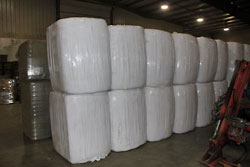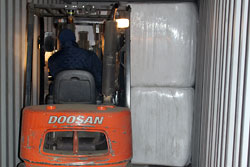Canadian Alfalfa Hay
Over the past four decades, the Canadian Alfalfa processing industry has experienced tremendous growth. Today, it ranks as one of the top five largest exporters of Alfalfa in the world. Alberta-grown Alfalfa hay offers many benefits and advantages when compared to hay grown in other parts of the world. Canadian Alfalfa hay provides farmers with a consistently higher quality product, while also offering a more rapid harvesting time than many other types of hay.
Because of its high protein content, farmers across Canada and the United States use dehydrated Alfalfa hay as food for their livestock. The soil on the eastern slopes of the Canadian Rockies is rich in calcium and magnesium, which helps to produce a more robust, nutrient rich hay.
The clean air, long warm days, and cool nights in Canada ensure a vigorous production  during the shorter growing season. Dry land alfalfa hay may be harvested up to twice per season, while irrigated alfalfa hay can be harvested up to three times each season. Because of it has a deep perennial root system, Alfalfa hay is a high water use forage crop. Although it optimally requires 540 to 680 mm of water per growing season in Alberta, the crop is relatively drought tolerant.
during the shorter growing season. Dry land alfalfa hay may be harvested up to twice per season, while irrigated alfalfa hay can be harvested up to three times each season. Because of it has a deep perennial root system, Alfalfa hay is a high water use forage crop. Although it optimally requires 540 to 680 mm of water per growing season in Alberta, the crop is relatively drought tolerant.
The long Canadian winters allow farmers to grow Alfalfa hay using more natural methods. This significantly reduces the need for pesticides and herbicides, as the cold temperatures effectively discourage pests and most weeds. The shorter growing season allows the land a greater resting period to recuperate. This recovery time helps eliminate the need for artificial fertilizers to coax more production, as is commonly necessary in areas with warmer climates.
This non-GMO crop also offers more stringent quality control guidelines. Instead of being graded by observation and smell the way Timothy hay is, Alfalfa hay is tested and graded by independent labs. Canadian Alfalfa hay promises a more consistent product, year after year.
Barr-Ag is a family-owned operation with a farm-to-farm business model. This allows them the unique ability to maintain much tighter control over the product they export. Barr-Ag’s farms and producers are strategically positioned near the eastern slopes of the Canadian Rocky Mountains where they are fortunate to have clean air, long warm days with cool nights, soil rich in calcium and magnesium and a pristine environment in which to grow their non-GMO alfalfa hay.
Growing 60% of all exported hay ensures that they can set high standards in place at each stage of their product, from planting to packaging. The remaining 40% of their stock is purchased from local growers with the same dedication to quality. Barr-Ag’s quality standards allow them to guarantee mold-free hay with less than 12% moisture content.
Contact Barr Ag to get more information on any or our crops including Alfalfa, Timothy, Mixed Hay, Canadian Grains and Pulse corps.








